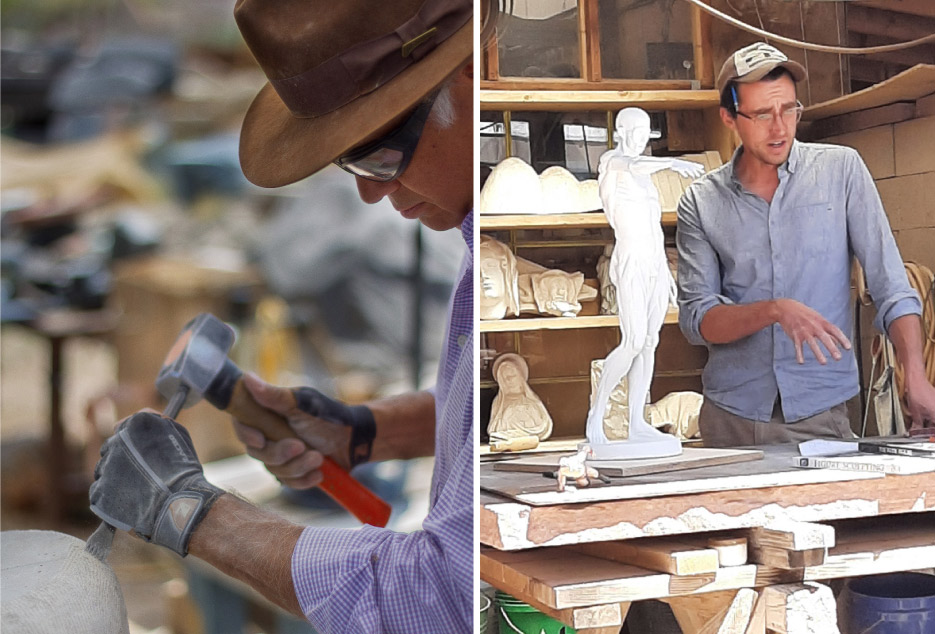Hands On Stone
Mark Saxe
Southwest Stoneworks
Photos courtesy Southwest Stoneworks & Kevin O’Connell
Stone has the potential to become a thing of beauty, a thing that can capture the essence of a thought or feeling the way a well-worn catcher’s mitt can catch a fastball.
 |
|
The hands of 40 years of stone carving experience. For the past 22 years, the Saxe Stone Carving Symposium has helped to keep the art of stone carving alive. |
I have been working with stone for over forty years. Forty years is a long time to stick with anything, especially these days, when our attention span is goaded on all sides to become shorter. We have come to expect immediate satisfaction. But stone carvers buck this trend. Stone working is a slow process, and patience is the coin of the realm.
Twenty-two years ago, we decided to start offering seven-day intensive classes as a way to support the continuation of this slow art of carving. The first inklings of offering a workshop at my stone yard had come to me as the result of a visit to the Cathedral of St. John the Divine in New York City during the carving program which was established to complete the cathedral’s towers. Apprentice carvers served under the tutelage of master stone carvers, learning to cut, shape, and carve the thousands of stones that would be necessary. When that program ended in 1992, a huge gap in the tradition was left, and it is that gap which we, in our own small way, are trying to fill. (Learn more about the Cathedral at www.divinestone.org, a blog begun in 2020 by Roger Murphy, a regular student in our classes, to document the program, carvings, and construction of the Cathedral.)
 |
|
Mark Saxe: “We recently formed a non-profit, The Rio Grande Rift Institute, in order to facilitate scholarships for young people interested in learning to work with their hands. Our first scholarship was awarded in 2021 to a local high school student.” |
It took years to perfect the ins and outs of every aspect of the workshops, but in 2020, COVID threw everything off. Needless to say, the last two years of classes were different from any we had done before, with travel bans and limitations on gatherings. We had to adjust. But our commitment to teaching held steady and now we are returning to a semblance of normalcy with this summer’s two classes, guest instructors and students from out of state, and pre-COVID enrollment numbers.
We start with the basics: geology of carving stones, tool selection and care, splitting and shaping the stone in preparation for carving, laying out, where and how to begin, where one is most likely to meet trouble, roughing out, proper carving techniques, texturing, finishing, lettering, and rigging. The instructors at the workshop have decades of know-how. They have devoted their lives to this obdurate, beautiful, natural material. With a typical teacher to student ratio of 1 to 5, our focus is on individual instruction. We try to provide everything a student needs to complete a modest project within the confines of the seven-day period. Some returning students work on a single piece throughout the course of several workshops spanning several years. We strive to expose each student to as many techniques as possible, such that when they leave, they have the confidence to continue on their own. They have learned to recognize what they do not know.
The standards for the greatest carvings ever produced are in museums all around the world, all of them carved by the hands of carvers who spent years, decades, honing their skills. In our classes, we try our best to focus on what makes a piece successful and on developing the hand and the eye to recognize and produce good work. Looking at the sculptures of antiquity is a start. In our library, students have access to over 500 books on sculpture and carving. Our collection of plaster models and maquettes helps students visualize various features in three dimensions. Videos shown throughout the week of some of the great sculptors at work give students a glimpse of what it takes to ‘make it’ as a stone carver. And what connects everything and gives it meaning is the deep well of experience of our instructors.
 |
|
Left: Returning student Ray Alvarado has attended the symposium for the past 6-7 years. |
More than ever before, I now sense the need and urgency of contributing what I can to keep stone carving alive and thriving. While we, as a culture, bemoan the loss of hand skills, maybe there is a quiet and unexpected resurgence going on in our midst - thanks, ironically, to machines such as the CNC which take much of the drudgery out of the initial stages of stone carving. More skilled carvers are needed for executing final details of public sculptures and commissions begun using the CNC process. In fact, this need for the skilled human hand and eye as the work nears completion promises to be with us for a while. For as long as a machine cannot replace a human in every single aspect of carving, industry needs skilled carvers.
Visit the website for additional info: www.saxstonecarving.com .